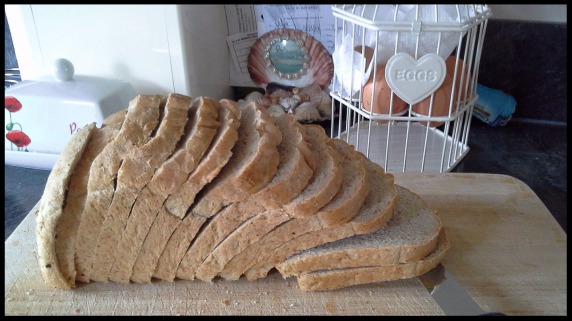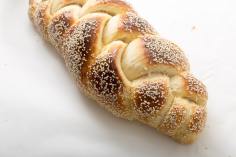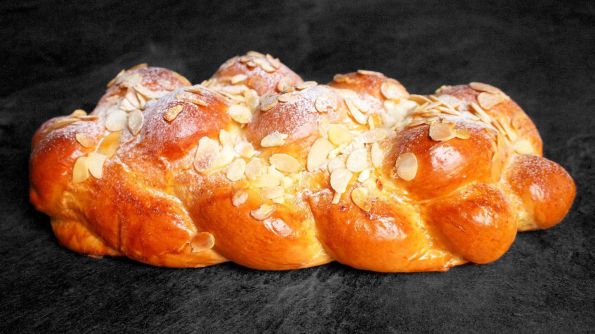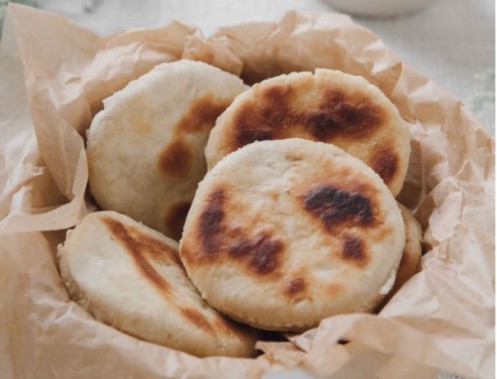Our bread recipe
Makes 2 x 1lb loaves
In a measuring jug, mix:
• 6 flat teaspoons of longlife yeast
• 1 pint (20 fluid ounces) or 600ml of warm water
• Half teaspoon of honey
In a bowl, mix:
• 2lb / 1kg of bread flour
• 2 teaspoons of salt
• Drizzle of oil
• Stir the honey, yeast and warm water and leave to froth (about 10 minutes)
• Rub the oil, flour and salt together until there are no lumps
• Combine yeast mixture and flour;
• Knead well (15 - 20 minutes)
• Leave in a warm place to rise until doubled in size
• Knead again, gently for a couple of minutes
• Shape and place in bread tins or on trays to make rolls or shaped bread.
• Leave to rise again until doubled in size
• Bake at 200° C or Gas Mark 6 for 30 minutes (loaf) or 20 minutes (rolls). Cooked bread sounds hollow when it is tapped on the bottom.
• Cool on a rack.
A few points...
Freezes well and makes great toast!
Vegans can substitute sugar for honey.
If you have any special requirements please ask a facilitator duriing the breadmaking session or contact us before you arrive.
Follow this link to watch Laura making bread and discussing life during lockdown. Laura is a trustee and also Methodist University Chaplain for the Liverpool Universities. She was our One Programme Participant during 2019 - 2020.
Peter's Tuesday Loaf
"Tuesday's bread cooled in the fridge overnight, sliced on a heavy wooden board, cut with a sharp serrated bread saw. First 2 slices toasted with lashings of butter, the rest placed in the freezer."
Peter Harvey, facilitator.
Heather's Mum's Easter Biscuit Recipe
HEATHER’S MUM’S EASTER BISCUITS
Soft-centred and lemony, these are a ‘must’ at the Easter table for all members of the Youngs’ family!
15 mins preparation; 10-12 mins cooking time.
Makes 12.
Ingredients:
8oz/200g self-raising flour
Small pinch salt
4oz/100g butter/margarine or a mixture of both
1/4lb/100g castor sugar
2oz/50g currants
Grated rind of 1 lemon
1 egg, lightly beaten
Method:
Preheat oven to 180°C/350°F, Gas mark 4; (fan oven 160°C/315°F, gas mark 3).
Grease baking tray.
Sieve flour with salt.
Cut up butter or margarine and rub into flour mixture.
Add sugar, lemon rind and currants; bind with egg.
Roll out on lightly floured work surface to ¼”/0.5cm thick; cut with 3”/7-8cm cutter and place on baking tray.
Bake for 10-12 minutes; keep checking after 10 mins; do not allow to brown.
Sprinkle with castor sugar. Cool on pan.
Store in tin.
Challah Bread Recipe - Passover bread
Here is the challah recipe that Heather adapted to be similar to how we begin our usual bread recipe.
'It is an Eastern European loaf from the Ashkenazi Jewish tradition. Challah is a special bread of Eastern European origin in Ashkenazi Jewish cuisine, usually braided and typically eaten on ceremonial occasions such as Shabbat and major Jewish holidays. Ritually-acceptable challah is made of dough from which a small portion has been set aside as an offering. Challah may also refer to the dough offering, and any bread that is made for Shabbat, or from which an offering is taken.' (Information from Wikipedia.)
This recipe makes 2 loaves which you are encouraged to share with a friend, neighbour or stranger, as is the tradition at Somewhere Else.
Image by Tetiana Shyshkina on Unsplash.
CHALLAH
Makes 2 loaves
Ingredients
1¾ lb/850g strong white flour
2 teaspoons salt
2 x 7g sachets or 6 teaspoons fine, granulated active dried yeast or instant yeast
1 teaspoon honey
About ½ pint/300ml warm water
2 large eggs, beaten
100ml sunflower/rapeseed oil
For the glaze
1 egg
Poppy seeds (approx. 1 tablespoon)
Equipment needed:
Large mixing bowl, small bowl, scales, measuring jug
Teaspoon, fork, knife, tablespoon
Clean tea towel
2 x baking sheets
Mug, pastry brush
Method:
Dissolve the yeast and honey in the warm water. Mix the flour and salt in a warm bowl. Make a well in the centre and pour in the yeast mixture, then add the beaten eggs and oil. Mix the ingredients in the well and then gradually incorporate the flour to make a soft, but not sticky dough. If too dry, work in warm water 1 tablespoon at a time; if too sticky, work in extra flour 1 tablespoon at a time. Knead well for about 10 minutes on a lightly floured work surface until very smooth and elastic. Form the dough into a ball and place back in the bowl.
Cover with a clean tea towel and allow to rise in a warm place until doubled in size, 45 minutes to an hour. Knead the dough briefly on the floured work surface, and divide into two. Cut each half into 3 pieces and form them into sausage shapes. Roll each piece into a long, thin snake (approx. 1.5 inches x 18 inches) and use them to make 2 long, fairly loose plaits. Turn the ends under so that they meet.
Place the plaits on greased baking sheets and cover lightly with the clean tea towel. Leave in a warm place to prove until swollen and puffy.
Meanwhile pre-heat oven to 220°C, Gas Mark 7.
Beat the remaining egg in the mug with a few drops of water and carefully brush the surfaces of the loaves. Then sprinkle them well with poppy seeds.
Bake for about 30 minutes; after 15 mins reduce heat to 180°C, Gas Mark 4, covering the loaves very loosely with foil if they seem to be getting too brown. Cool on a rack, and eat warm or cold.
Festive Bread Recipes
Vánočka - Czech Christmas bread
A recipe shared by Monika from Prague, a former Vincentian Volunteer at SWE.
For the Bread:
1/2 cup butter
1 cup sugar
1/2 teaspoon salt
1 cup milk
2 packages active dry yeast
1/4 cup water
2 large eggs (beaten)
5 1/2 cups all-purpose flour
1/2 cup raisins
1/2 cup almonds (blanched and sliced)
1/3 cup lemon zest
For the Topping:
1 large egg (beaten)
2 tablespoons almonds (blanched and sliced)
Heat the milk so that it is lukewarm. Measure 1 teaspoon from the 3/4 cup of sugar and stir this into the milk along with the yeast. Leave it to bubble and froth (about 10 minutes). Meanwhile, put flour, the rest of the sugar and salt into a large bowl and mix. Add lemon zest, egg yolks and melted butter, mixing well. Once the yeast is ready, add it to the bowl along with the dried fruit and mix to combine.
Knead the dough, so that it is well combined. The dough should be slightly sticky. Take the dough out of the bowl and dust the sides and bottom of the bowl with flour. Place the dough back into the bowl, cover with a tea towel and put it in a warm place for 2 hours to rise.
Put the dough on a floured board and divide it into 3 bigger pieces and 5 smaller ones. Roll each piece into a rope, about an inch thick. Braid the 3 larger pieces and pinch ends together. Braid 3 of the smaller ropes, press ends together, and place on top of the large braid. Twist the last 2 pieces together and place on top of the second braid.
Cover with a cloth and let it prove in a warm place for about an hour. Heat the oven to 180 °C. Brush the bread with egg wash and sprinkle with almonds. Bake approximately 45 minutes. Let it cool down. You can also dust it with icing sugar.
Diphaphatha - Stovetop muffins
A recipe shared by Lesogo Connie Magole - a member of the SWE community
Diphaphatha are so simple to make and come together in less than 30 minutes, and that includes 15 minutes of resting time (for both the dough and you).
Combine ingredients in large bowl, kneading dough for about 3 minutes.
Cover dough and leave to rest for 15 minutes.
Roll out dough and cut into circles.
Cook dough circles on hot pan for about 2 minutes per side and serve!
Ingredients
SERVINGS 8 muffins
INGREDIENTS
2 cups all-purpose flour
2 tsp baking powder (or 1 tsp yeast)
1/2 tsp salt
1 tsp white sugar
1/2 cup milk (dairy or non-dairy)
1 tbsp butter
INSTRUCTIONS
In a large bowl, whisk together flour, baking powder, salt and sugar.
Slowly add in milk to flour mixture and stir to combine. Knead for 3 minutes until a soft, smooth dough has formed.
Cover dough and allow to rest for 15 minutes.
Dust bench with flour and roll out dough to half a centimetre thick.
Use a round cookie cutter or bowl with sharp edges to cut rounds, around 8cm in diameter.
Heat a flat pan over high heat. Add one tablespoon of butter. Once melted, reduce heat to medium.
Place as many dough rounds as you can fit on the pan and cook for 2 minutes on each side or until they go slightly brown and puffy.
Leave for a few minutes before slicing in half and serving with your favourite toppings!






